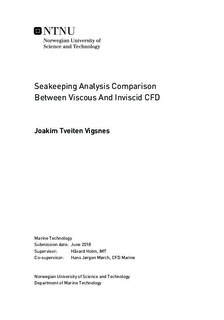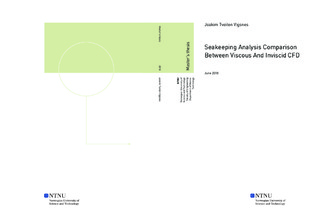| dc.description.abstract | With the global community's increased focus on a green and more sustainable environment, stricter demands are being invoked on ship design. Consequently, knowledge on how the vessel responds in a realistic sea-condition is needed, in order to hydrodynamically optimize the hull. Accurate calculations on this topic has been the domain of model tests and viscous CFD simulations. However, since time is of the essence with regards to engineering analysis, and both model-testing and viscous CFD simulations still are time-consuming analyses, there is a need for more efficient ways of accurate calculation.
This thesis investigates the applicability of inviscid CFD simulations to seakeeping analysis. As ship resistance and motions in waves is widely regarded as a pressure-dominated system, the hypothesis is that the inviscid simulation should not differ by too much, compared to viscous CFD results. If the two simulations concur with regards to the results, the inviscid simulation should be the preferred method, as it is computationally faster. Both an inviscid and RANS-simulation are done for calm-water, head-wave and oblique-wave condition.
The vessel used in the analyses is the ship model KVLCC2, at a 1:58 scale, and the commercial software STAR-CCM+ is used for the CFD-simulations. From the CFD workshop in Gothenburg 2010 experimental results for the calm-water and head-wave simulations were obtained. As there did not exist any published experimental results on the oblique wave-condition, it was crucial that the calm-water and head-wave simulations agreed with the experimental data. This way, the numerical set-up could be verified and the oblique-condition results would have more credibility.
A numerical wave tank was set up, and a flat VOF-wave and a 5th order approximation to the Stokes wave was used to model the calm-water and wave-simulations, respectively. The overset mesh technique has been implemented for the wave-analyses, in order to cope with the large motions that occur. The model was allowed to move in heave and pitch for the calm-water and head-wave simulations. In oblique wave conditions, the vessel was also allowed to move in roll.
For the calm water condition, the inviscid simulation was unable to compute the pressure resistance, due to the fact that the pressure resistance was dominated by viscous forces. Only able to calculate approximately $35\%$ of the pressure force, the inviscid solver is deemed not applicable for this condition. This is due to the low Froude number of the vessel, Fn=0.142, and it is expected that for larger Froude numbers, the difference between the viscous and inviscid simulation will become smaller.
The results obtained for the wave-conditions in this thesis indicates that the inviscid solver was able to compute the resistance and motions in waves to a satisfactory level of accuracy. With the inclusion of the calm water frictional resistance a $2.988\%$ deviancy from experimental results was obtained for the total resistance in the head-wave condition. It also achieved a level of accuracy for the motions that outperformed some of the results published in the 2010 CFD workshop, [\cite{Exp_res2010}]. For oblique waves it managed to obtain a $4.4\%$, $0.06\%$, $5.29\%$ and $11.9\%$ deviancy for the pressure resistance, heave-, roll- and pitch-motion, respectively for the 0th harmonic amplitude of the time-series. These results, along with the head-wave simulation, suffered from an asymmetric representation of the surface-elevation, around the mean-free-surface at for calm waters. Still, they do indicate that the forces and motions occurring are pressure-dominated.
It was found that the frictional resistance varied substantially with wave-heading angle, and that there was no computational gain with an inviscid solver for oblique conditions. Without a better estimate for the frictional resistance than the calm water resistance, and improved computational efficiency, the inviscid solver is deemed as not applicable, on the basis of the results obtained in this thesis. | |

